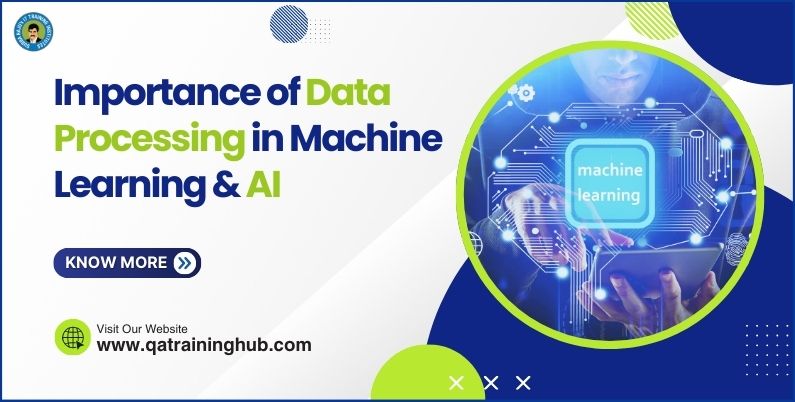
How about AI & Machine Learning in Software Testing?
Ensuring the quality and dependability of software applications is more critical than ever in today’s fast-changing world of software development. As businesses depend more on digital solutions, they need their software to provide smooth and efficient user experiences. This means that software testing must be quicker, more precise, and more thorough to meet these demands, this has made it necessary for software testing to be faster, more accurate, and more thorough. Traditional methods, though effective, often can’t keep up because they are manual and require a lot of tests for complex systems. In this we will discuss about AI and Machine Learning in Software Testing.
The Need for AI and ML in Software Testing
Software testing is a crucial part of development, making sure applications work correctly and meet user expectations. However, traditional testing methods have several challenges:
Volume and Complexity: Modern applications are complicated and often need a lot of testing on different platforms and environments.
Time Constraints: Manual testing takes a lot of time and can slow down the release of software updates and new features.
Resource Intensive: It needs a lot of people, which can be expensive.
Human Error: Manual testing can have human errors, causing some defects to be missed. AI and ML can help solve these problems by automating and improving parts of the testing process, making it more efficient, accurate, and cost-effective.
How AI and ML are Transforming Software Testing
AI and ML are being used in different parts of the software testing process, from creating test cases to finding defects and more. Let’s take a closer look at how these technologies are changing things:
1. Test Case Generation and Optimization
AI has a big impact on software testing by automatically making test cases. AI looks at the software’s code, user stories, and past problems to make thorough test cases that cover many situations. This means testers don’t have to spend as much time making and keeping up with test cases.
Machine Learning models can improve existing test sets by finding tests that are no longer needed and suggesting changes or removals. This keeps the test set efficient, saving time when running tests.
2. Test Execution and Automation
AI-driven test automation tools can run test cases faster and smarter than traditional ways. They learn from past tests and adjust how they test, putting more effort into areas where problems often happen. For instance, if one part of the software often has issues, the AI tool will test that part first.
Additionally, AI can improve continuous testing by fitting well into CI/CD pipelines, allowing automated testing throughout the development process. This makes sure that any issues introduced during development are found and fixed quickly, lowering the chance of problems reaching production.
3. Defect Prediction and Analysis
Predictive analytics, using ML, can find parts of the software that might have more issues. ML looks at past data like past problems, code changes, and what developers do. ML can guess how likely it is that certain parts of the software will have problems. Testers can then spend more time on those parts, making testing more efficient.
Also, AI helps with defect analysis by sorting and ranking defects by how serious they are and how much they affect the software. This helps development teams fix the most important issues first, making sure the big problems are solved before the software is released.
4. Visual Testing and User Interface Validation
AI, especially in computer vision, has led to big improvements in visual testing and checking if user interfaces (UIs) are right. AI tools for visual testing can compare how a UI looks now to how it should look, finding any differences like layout problems, things missing, or how it looks wrong. Doing this accurately by hand is hard, especially for apps with complicated and changing interfaces.
Moreover, AI can simulate user interactions with the application, identifying potential usability issues and ensuring that the application provides a smooth user experience across different devices and screen sizes.
5. Natural Language Processing (NLP) for Test Automation
Natural Language Processing (NLP) is another AI technology that’s changing software testing. NLP can turn requirements and user stories written by humans into test scripts that computers can run. This helps non-technical people communicate better with the testing team, making sure tests match what the business needs.
NLP also helps development teams work together better by making documents, test reports, and other things in natural language automatically.
6. Self-Healing Test Automation
One of the most creative uses of AI in software testing is self-healing test automation. Regular test scripts often break easily with even small changes in how the application looks or works. AI can make these scripts tougher by fixing changes automatically. For instance, if something in the application moves, AI can find it and fix it in the test script without needing people to do it, making sure the tests keep working right.
Benefits of AI and ML in Software Testing
Integrating AI and ML into software testing has many benefits, including:
Increased Test Coverage: AI can create and run a lot of test cases, making sure the application is thoroughly tested.
Enhanced Accuracy: Reduces human error and increases the accuracy of test execution and defect detection.
Speed and Efficiency: It automates repetitive and time-consuming tasks, which makes the testing process much faster.
Cost Savings: It decreases the requirement for a lot of people working on it, which saves money in the long term.
Continuous Improvement: AI and ML systems get better as they learn from more data, becoming more effective over time.
Better Risk Management: Predictive analytics assist in Identifying high-risk areas, allowing teams to concentrate their efforts where they’re most necessary.
Difficulties and Things to Think About:
Although AI and ML provide significant benefits, it’s important to remember that there are also challenges and factors to consider.
Data Quality and Availability: AI and ML models need a lot of good data to work well. Getting enough of this data can be hard.
Integration with Existing Tools: Connecting AI and ML solutions to existing testing tools and processes can take a lot of work and resources.
Skill Gap: Introducing AI and ML into testing needs specific skills that might not be easily found in existing teams.
Maintenance and Monitoring: AI and ML systems must be consistently watched and looked after to make sure they work well and give accurate results.
Upcoming Developments
The outlook for AI and ML in software testing appears bright, with various new trends on the horizon that will influence the industry.
AI-Driven Test Management: AI will have a bigger part in handling the entire testing process, from planning and designing tests to running them and creating reports.
Enhanced Collaboration Tools: Collaboration tools powered by AI will help improve communication and coordination among development, testing, and business teams.
Advanced Defect Analytics: Predictive and prescriptive analytics will get more advanced, giving us better insights into patterns and trends related to defects.
Integration with DevOps: AI and ML will become essential parts of DevOps pipelines, allowing continuous testing and delivery on a large scale.
Conclusion:
In conclusion, the integration of AI and Machine Learning in Software Testing marks a significant change in how we ensure quality. With the increasing need for faster and more dependable software, businesses must adopt these technologies to remain competitive in today’s market.
At QA Training Hub, we understand how important AI and Machine Learning are in software testing. That’s why we provide high-quality training programs designed to give professionals the skills and knowledge they need to succeed in this fast-changing field. our courses cover the latest tools, techniques, and best practices in AI and Machine Learning in Software Testing. They help individuals and teams use these technologies to innovate and create high-quality software solutions.
By using AI and Machine Learning in Software Testing, organizations can make their testing processes more efficient, accurate, and scalable. These technologies automate repetitive tasks, improve test suites, and predict defects before they happen. This allows teams to concentrate on the most important tasks, leading to quicker time-to-market and customer satisfaction.
By teaming up with QA Training Hub, professionals can keep up with the latest trends and open up new avenues for growth and advancement in the field of software testing. Come along with us on the path to excellence in software testing, with AI and Machine Learning leading the way.


